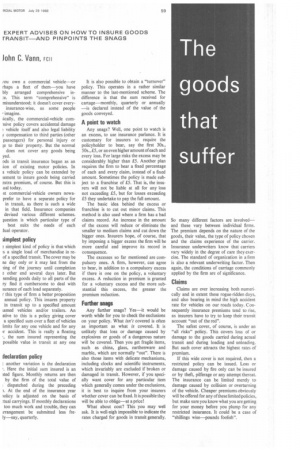John C. Vann, FCII
Page 61

If you've noticed an error in this article please click here to report it so we can fix it.
mu own a commercial vehicle—or rhaps a fleet of them—you have bly arranged comprehensive in e. term "comprehensive" is misunderstood; it doesn't cover everyinsurance-wise, as some people imagine.
kally, the commercial-vehicle cornisive policy covers accidental damage vehicle itself and also legal liability y compensation to third parties (other passengers) for personal injury or N to their property. But the normal does not cover any goods being
Yed
ods in transit insurance began as an don of existing motor policies. In a vehicle policy can be extended by sement to insure goods being carried extra premium, of course. But this is ual today.
st commercial-vehicle owners nowaprefer to have a separate policy for in transit, as there is such a wide in that field. Insurance companies devised various different schemes. Iuestion is which particular type of best suits the needs of each kat operator.
implest policy
a simplest kind of policy is that which s a single load of merchandise in reof a specified transit. The cover may be ne day only or it may last from the ling of the journey until completion a other end several days later. But sending goods daily to all parts of the ry find it cumbersome to deal with surance of each load separately.
r this type of firm a better proposition annual policy. This insures property in transit up to a specified amount kamed vehicles and/or trailers. An alive to this is a policy giving cover a specified sum over a fleet of vehicles [imits for any one vehicle and for any
■ taccident. This is really a floating the sum insured representing the possible value in transit at any one
declaration policy
another variation is the declaration r. Here the initial sum insured is an Wed figure. Monthly returns are then by the firm of the total value of dispatched during the preceding 1. At the end of the insurance year )olicy is adjusted on the basis of :nal carryings. If monthly declarations too much work and trouble, they can rrangement be submitted less frely—say, quarterly. It is also possible to obtain a "turnover" policy. This operates in a rather similar manner to the last-mentioned scheme. The difference is that the sum received for cartage—monthly, quarterly or annually —is declared instead of the value of the goods conveyed.
A point to watch
Any snags? Well, one point to watch is an excess, to use insurance parlance. It is customary for insurers to require the policyholder to bear, say the first 30s., 50s., £5, or an even higher amount of each and every loss. For large risks the excess may be considerably higher than £5. Another plan requires the firm to bear a fixed percentage of each and every claim, instead of a fixed amount. Sometimes the policy is made subject to a franchise of £5. That is, the insurers will not be liable at all for any loss not exceeding £5, but for losses exceeding £5 they undertake to pay the full amount.
The basic idea behind the excess or franchise is to cut out minor claims. This method is also used where a firm has a bad claims record. An increase in the amount of the excess will reduce or eliminate the smaller to medium claims and cut down the bigger ones. Insurers hope, of course, that by imposing a bigger excess the firm will be more careful and improve its record in consequence.
The excesses so far mentioned are compulsory ones. A firm, however, can agree to bear, in addition to a compulsory excess if there is one on the policy, a voluntary excess. A reduction in premium is granted for a voluntary excess and the more substantial this excess, the greater the premium reduction.
Further snags
Any further snags? Yes—it would be worth while for you to check the exclusions on your policy. What isn't covered is often as important as what is covered. It is unlikely that loss or damage caused by explosives or goods of a dangerous nature will be covered. Then you get fragile items, such as china, glass, earthenware and marble, which are normally "out". There is also those items with delicate mechanisms, including clocks and scientific instruments, which invariably are excluded if broken or damaged in transit. However, if you specially want cover for any particular item which generally comes under the exclusions, it is best to inquire from your insurers whether cover can be fixed. It is possible they will be able to oblige—at a price!
What about cost? This you may well ask. It is well-nigh impossible to indicate the rates charged for goods in transit generally.
So many different factors are involved and these vary between individual firms. The premium depends on the nature of the goods, their value, the type of policy chosen and the claims experience of the carrier. Insurance underwriters know that carriers vary widely in the degree of care they exercise. The standard of organization in a firm is also a relevant underwriting factor. Then again, the conditions of carriage commonly applied by the firm are of significance.
































































































































































